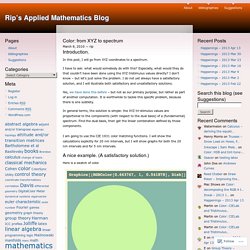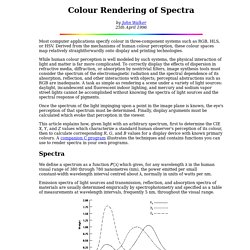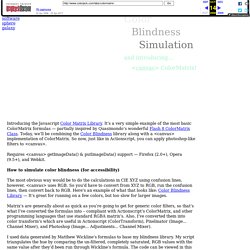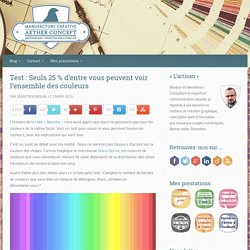

The red and green specialists: why human colour vision is so odd. Most mammals rely on scent rather than sight.

Look at a dog’s eyes, for example: they’re usually on the sides of its face, not close together and forward-facing like ours. Having eyes on the side is good for creating a broad field of vision, but bad for depth perception and accurately judging distances in front. Instead of having good vision, dogs, horses, mice, antelope – in fact, most mammals generally – have long damp snouts that they use to sniff things with. It is we humans, and apes and monkeys, who are different. And, as we will see, there is something particularly unusual about our vision that requires an explanation. Over time, perhaps as primates came to occupy more diurnal niches with lots of light to see, we somehow evolved to be less reliant on smell and more reliant on vision. DomainRedirect.html?uri=
OPTPROP is a general toolbox for various color conversions and calculations.

It is general in that in addition to handling various standard illuminants, observers and RGB color spaces, it can also handle custom specifications. It is a toolbox, in that it is not just a collection of routines. Instead, most routines have a common interface and can be combined seamlessly to form higher order routines. Programmer's Guide to XYZ, RGB. Written October 2013.

Updated February 2015. GitHub - colour-science/smits1999: An RGB to Spectrum Conversion for Reflectances. An RGB to Spectrum Conversion for Reflectances. This paper presents a solution to the problem of using RGB data created by most modeling systems in a spectrally-based renderer.

It differs from previous methods in that it attempts to create physically plausible spectra for reflectances. The method searches the metamer space for a spectrum that best fits a set of criteria. The results are used in an algorithm that is simple and efficient enough to be used within the rendering process for both importing models and for texture mapping. Postscript and pdf versions of the paper are available. Welcome to Bruce Lindbloom's Web Site. DomainRedirect.html?uri= Copyright (c) 2010, Jeff Mather All rights reserved.

Redistribution and use in source and binary forms, with or without modification, are permitted provided that the following conditions are met: * Redistributions of source code must retain the above copyright notice, this list of conditions and the following disclaimer. . * Redistributions in binary form must reproduce the above copyright notice, this list of conditions and the following disclaimer in the documentation and/or other materials provided with the distribution. Rip's Applied Mathematics Blog. Introduction.

In this post, I will go from XYZ coordinates to a spectrum. Colour Rendering of Spectra. Most computer applications specify colour in three-component systems such as RGB, HLS, or HSV.

Derived from the mechanisms of human colour perception, these colour spaces map relatively straightforwardly onto display and printing technologies. While human colour perception is well modeled by such systems, the physical interaction of light and matter is far more complicated. To correctly display the effects of dispersion in refractive media, diffraction, or absorption by nontrivial filters, image synthesis tools must consider the spectrum of the electromagnetic radiation and the spectral dependence of its absorption, reflection, and other interactions with objects; perceptual abstractions such as RGB are inadequate.
Once the spectrum of the light impinging upon a point in the image plane is known, the eye's perception of that spectrum must be determined. Color.Vision.Simulate. Color.Vision.Daltonize. <canvas> + ColorMatrix = Color Blindness. Introducing the Javascript Color Matrix Library.

It’s a very simple example of the most basic ColorMatrix formulas — partially inspired by Quasimondo’s wonderful Flash 8 ColorMatrix Class. Today, we’ll be combining the Color Blindness library along with a Requires <canvas> getImageData() & putImageData() support — Firefox (2.0+), Opera (9.5+), and Webkit. NoFunc · Color Blindness Library ( Javascript ) This function allows you to simulate common and uncommon color blindness.

Use the fBlind[] in order to convert. Color For The Color Blind. Strong Deutan. COMMENT LES DALTONIENS VOIENT LE MONDE. Mon score :-( Color Test - Online Color Challenge. Test : Seuls 25 % d’entre vous peuvent voir l’ensemble des couleurs. L’histoire de la robe « bleuche » nous aura appris que nous ne percevons pas tous les couleurs de la même façon.

Voici un test pour savoir si vous percevez toutes les couleurs, avec les explications qui vont bien. C’est un sujet de débat avec ma moitié : Nous ne sommes pas toujours d’accord sur la couleur des choses. Comme l’explique la chercheuse Diana Derval, les nuances de couleurs que nous sommes en mesure de voire dépendent de la distribution des cônes (récepteurs de couleurs) dans nos yeux. Avant d’aller plus loin, faites alors ce simple petit test : Comptez le nombre de bandes de couleurs que vous êtes en mesure de distinguer. Alors, combien en dénombrez-vous ? Daltonize: Bookmarklet. Developers Lounge. About Daltonize. Sim Daltonisme. Comment voit un daltonien au feu rouge ? Les daltoniens. Les premières questions que l’on pose à un daltonien (et je suis bien placé pour le dire), sont souvent les suivantes : "Comment vois-tu telle couleur", ou "Et ça, c’est quelle couleur pour toi ?
", et encore "alors quelles couleurs vois-tu à la place"... Tant de questions banales que nous, daltonien, nous ne pouvons pas réellement répondre : comment décrire sa façon de voir à quelqu’un ??? En fait on ne peut pas répondre par des mots, et comme chaque daltonien à sa propre vision (du fait du degré de daltonisme), il n’y a même pas une réponse, mais plusieurs.